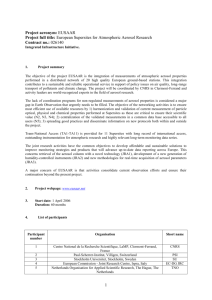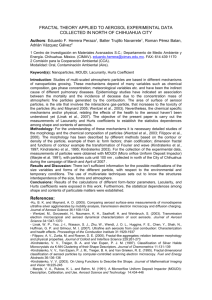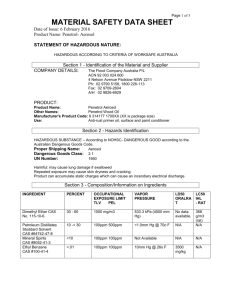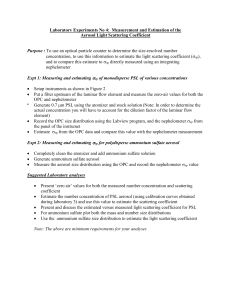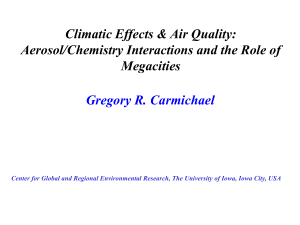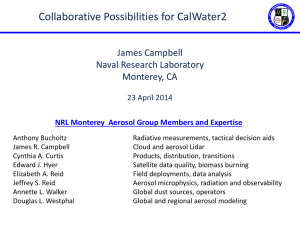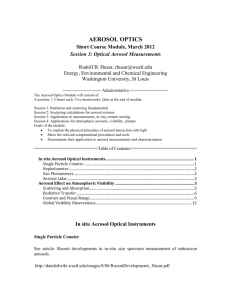EGU Poster Outline - Division of Geological and Planetary
advertisement
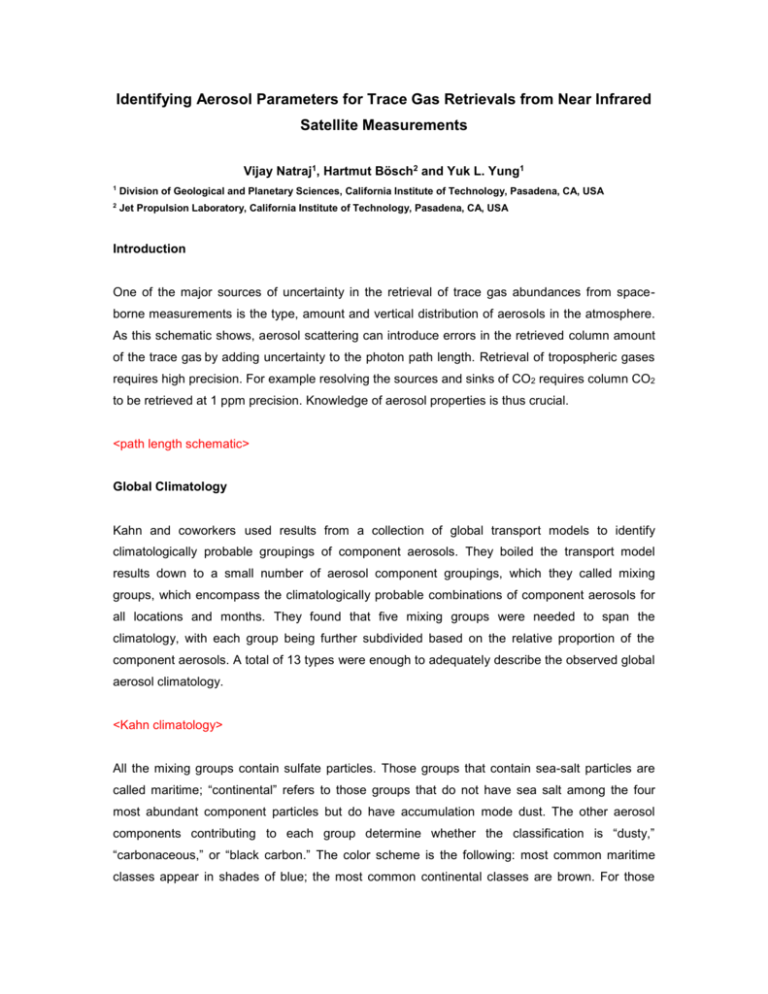
Identifying Aerosol Parameters for Trace Gas Retrievals from Near Infrared Satellite Measurements Vijay Natraj1, Hartmut Bösch2 and Yuk L. Yung1 1 Division of Geological and Planetary Sciences, California Institute of Technology, Pasadena, CA, USA 2 Jet Propulsion Laboratory, California Institute of Technology, Pasadena, CA, USA Introduction One of the major sources of uncertainty in the retrieval of trace gas abundances from spaceborne measurements is the type, amount and vertical distribution of aerosols in the atmosphere. As this schematic shows, aerosol scattering can introduce errors in the retrieved column amount of the trace gas by adding uncertainty to the photon path length. Retrieval of tropospheric gases requires high precision. For example resolving the sources and sinks of CO2 requires column CO2 to be retrieved at 1 ppm precision. Knowledge of aerosol properties is thus crucial. <path length schematic> Global Climatology Kahn and coworkers used results from a collection of global transport models to identify climatologically probable groupings of component aerosols. They boiled the transport model results down to a small number of aerosol component groupings, which they called mixing groups, which encompass the climatologically probable combinations of component aerosols for all locations and months. They found that five mixing groups were needed to span the climatology, with each group being further subdivided based on the relative proportion of the component aerosols. A total of 13 types were enough to adequately describe the observed global aerosol climatology. <Kahn climatology> All the mixing groups contain sulfate particles. Those groups that contain sea-salt particles are called maritime; “continental” refers to those groups that do not have sea salt among the four most abundant component particles but do have accumulation mode dust. The other aerosol components contributing to each group determine whether the classification is “dusty,” “carbonaceous,” or “black carbon.” The color scheme is the following: most common maritime classes appear in shades of blue; the most common continental classes are brown. For those that remain, classes rich in black carbon are gray, those having high carbonaceous aerosol fraction are green, and the ones abundant in coarse dust are yellow. Optical Properties We computed the aerosol optical properties using Mie and T-matrix codes depending on their shape. In correspondence with standard practice, we used a lognormal size distribution. We also took full account of polarization because for near infrared retrievals it could be a significant component of the error budget, especially for polarization-sensitive instruments such as those on GOME, SCIAMACHY and OCO. A sample scattering matrix looks like this. We have plotted the phase function and the (1,2) element, which accounts for linear polarization It is clear that the 13 types do not all have different radiative effects and that polarization causes a wider spread. <phase plots for components and the 13 types> Forward Model Details Here are some details of the forward model calculations. We considered a scene over Park Falls, Wisconsin, in July. The solar zenith angle for this case is about 31 degrees, which corresponds to a 150 degree scattering angle for nadir viewing. We assumed an exponential extinction for the aerosol, with a scale height of about 1 km and a total optical depth of 0.1. The Orbiting Carbon Observatory (OCO) spectral regions (0.76 μm O2 A band and CO2 bands at 1.61 μm and 2.06 μm) were used. The multiple scattering code RADIANT was used, with a single scattering approximation for polarization. We used a Lorentzian instrument lineshape function, with resolving powers of 17000 for the O2 A band and 20000 for the CO2 bands. Weighting Functions We computed weighting functions for each of the spectral regions to determine the change in observed radiance when the aerosol optical depth was changed. The color coding is such that each mixing group is represented by one color, with different linestyles used for the subdivisions. Just by looking at the weighting functions it is clear that the 13 different aerosol groups do not all have different effects as far as the retrieval is concerned. <weighting function plots> Retrieval Groups We attempted to split these groups into retrieval groups based on the variation of the single scattering albedo and extinction cross section with wavelength and found surprisingly good results. We obtained 5 different retrieval groups, which represent aerosol types exhibiting different physics. For example, groups 5 and 4 differ because group 4 contains accumulation mode dust, which is absorbing while group 5 contains seasalt which has a single scattering albedo of 1, even though they are very similar otherwise. <extinction and ssa plots> Sensitivity Tests We did some sensitivity tests to find out the error due to choosing a wrong aerosol type within a retrieval group. The results show that these errors are smaller than the measurement noise and the smoothing error. <sensitivity analysis results> Conclusions We used the weighting function behavior of basic aerosol mixing groups to arrive at aerosol retrieval groups. Sensitivity tests indicated that choosing a wrong aerosol type within a retrieval group introduced minimal errors. It should be mentioned that we need to test more scattering geometries to ensure that a weighting function analysis would give us the same retrieval groups. Also, more realistic aerosol vertical profiles need to be considered. References 1. Kahn et al. 2. de Rooij et al. 3. Mishchenko et al. 4. OCO 5. Radiant

